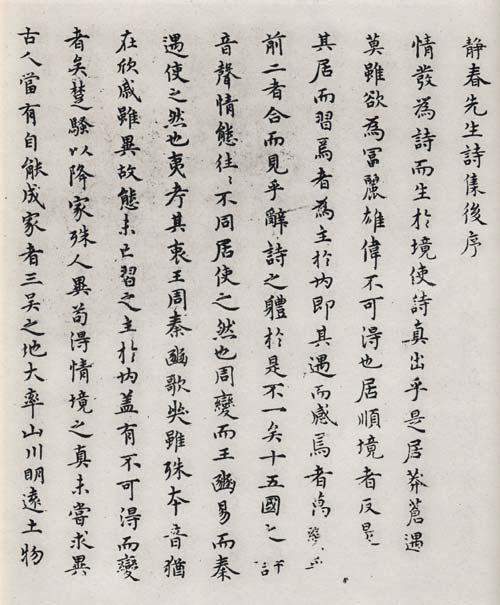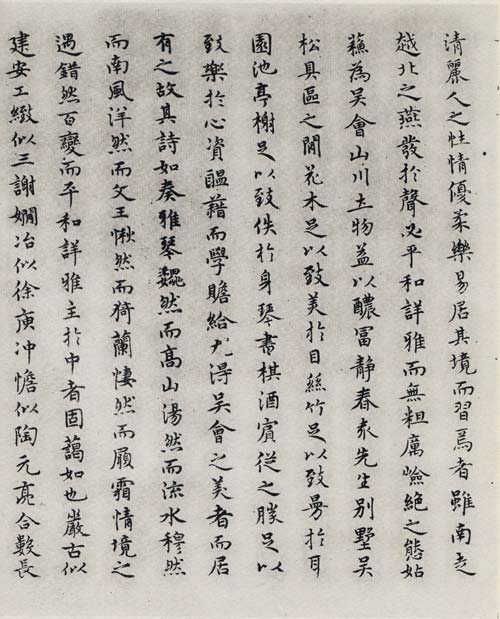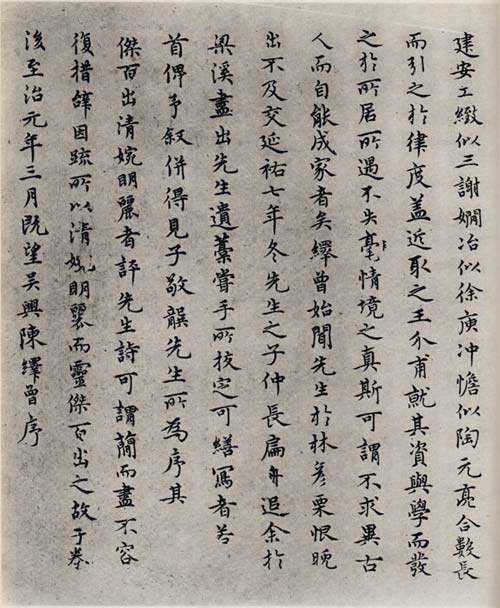Chen Yi was a calligrapher during the Yuantong and Zhizheng years of the Yuan Dynasty. His courtesy name was Bofu, and his first name was Bofu. He was a native of Chuzhou (now Lishui, Zhejiang Province). Although he stuttered a bit, he was extremely alert and could recite many of the sutras and commentaries in entire sections. His diction was vast and eloquent, and he was good at cursive and seal calligraphy. He served as an assistant teacher at the Imperial Academy. In the third year of Zhizheng of the Yuan Dynasty (1343), he served as editor and editor of the Academy of National History, and edited "History of Liao". He is the author of "The Original Image of Calligraphy", "Essentials of Hanlin", "On Wenquan Genealogy", "Ancient and Modern Literary Styles", "Grades of Imperial Examinations", etc.



Chen Yizeng's "Preface to the Collected Poems of Mr. Jingchun" on paper, 31.2 x 49.5 cm, collected by the Palace Museum in Beijing.
Jingchun Hall is the name of the Zhaitang where Yuan Yi lived. "Jingchuntang Poetry Collection" was compiled by Yuan Zhongchang, the second son of Yuan Yi, who compiled his father's manuscripts and asked his father's friends to write a preface. "The Preface to the Collection of Poems by Mr. Jingchun" written by Chen Yizeng is a section of the preface to the "Collection of Poems by Jingchun Hall" written by people in the Yuan Dynasty. In addition to Chen Yizeng, there are also prefaces written by Gong Ying, Lu Wengui, Yang Zai, Tang Michang and others, postscripts written by Yu Ji and Guo Linsun, poems written by Qian Chongding, and the "Epitaph of Mr. Yuan Jun, Mr. Jingchun" written by Huang Shu. From the preface and the inscription "Wang in March of the first year of Zhizhi", it can be inferred that Chen Yizeng painted this work in 1321.
Tao Zongyi's "History of Calligraphy" records: "Chen Yi was good at calligraphy. He was familiar with both cursive, seal, and official script, and each had his own method." However, very few of Chen Yizeng's ink writings have been handed down, and this is his representative work. Chen Yizeng's small regular script was modeled after the Wei and Jin Dynasties. His works have a stable structure, dignified and simple posture, gentleness and vigor, strict rules and vivid mood. Although this work is not powerful and powerful, it has the style of Jin and Tang calligraphy, and it also has its own certain style, with a graceful and elegant style. This effect makes the pen fine and delicate, and the place where the pen touches is elegant and elegant. He deliberately made the length, length, and straightness of the stipples follow the shape of the characters. The more complex the strokes, the larger the strokes, while the simpler the strokes, the smaller. The stipples in the work are mainly round pens, which are round and full, and the writing is honest and powerful, just like throwing bricks and stones, which makes people dare not imitate it with false meaning. At the same time, in the calm and implicit brushwork, there is a kind of "Tao and God" nature integrated into it. In terms of layout, the word spacing is relatively loose, and the distance between lines is widened to make the work appear wide and stretched, thus reflecting the effect of seeing small things as large and seeing dense things as sparse.
Here, I have to mention the important work "Essentials of Hanlin" by Chen Yizeng. There were many theoretical works on calligraphy in the Yuan Dynasty, some of which were general works and some were series. "Essentials of Hanlin" written by Chen Yizeng belongs to the category of calligraphy techniques. The book has various names for various methods such as the writing method, the blood method, the bone method, the tendon method, the straight method, the round method, etc., and discusses them one by one, with detailed and unique explanations. Because of this, people attach great importance to "Essentials of Hanlin". In the article "Blood Method", he said: "Words are born from ink, and ink is born from water. Water is the blood of words." He also said: "When the tip of the pen is exposed to water, a little bit has withered. Ink and ink are all hidden in the brush. Inside, if you squat, the water will be underwater, if you stand, the water will gather, and if you lift it, all the water will fall into the paper." Chen Yi once discussed the relationship between the writer's emotions and calligraphy equally brilliantly. He wrote: "Emotions are heavy and light, and even the words are gentle, soft, dangerous, and beautiful, but also shallow and deep, with endless changes." How to change? Specifically: "Happiness means that the Qi is harmonious and the characters are relaxed; anger means that the Qi is thick and the characters are dangerous; sadness means that the Qi is depressed and the characters are condensed; joy means that the Qi is flat and the characters are beautiful." When a person is happy, the Qi in the heart is harmonious, and the characters written will be relaxed. When a person is angry, his heart is rough and stuffy, and the words he writes are dangerous; when a person is sad, his heart is melancholy, and his words are restrained; when a person is happy, his heart is calm, and his words are beautiful. In short, people's thoughts, interests, aspirations and pursuits of joy, anger, sorrow and joy will be reflected in the expression and style of words. From this point of view, let’s look at this small regular script work by Chen Yizeng. Although it is not astonishing, it is of lasting interest. The strokes are tactful, the rhythm is gentle, the knots are elegant and natural, and the subtle points are often plain and plain, giving people a comfortable and pleasant feeling. It must have been written by Chen Yi in a calm state. The whole work has Xiao Yuan's natural elegance, without any vulgar or crude wildness. It is just like a fresh and smooth pastoral poem, which contains a sparse, elegant and quiet mood. As long as you immerse yourself in it, you will be like the author. A feeling of joy arises in the heart.








